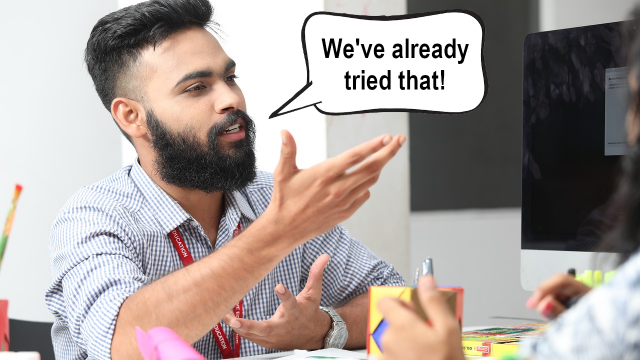
Lessons Learned Part 6: Ten Tips for Facilitating After Action Reviews
This article is part 6 of a series of articles exploring the Lessons Learned Life Cycle.
In my previous post I described the After Action Review as a useful method for capturing lessons learned. Having facilitated quite a few of these during my career, here are some tips I collected to help ensure your AAR is successful. There are many general books out there on how to be a good facilitator and run a meeting. I’m not covering those here but instead am focusing specifically on tips for AAR meetings.
- It helps to have a facilitator who is not part of the department or team, someone who has not been close to the action. People who have been intimately involved in the activity can find it difficult to separate themselves from the discussion and can easily gloss over issues without really digging into them. The ideal facilitator is someone who is part of the organization but not part of the team. In other words, they know enough about the project or activity to understand the purpose, the culture, maybe even some of the jargon. But they are far enough away from the activity that they won’t get swept up in the discussion as a participant, especially if that discussion becomes emotional. A facilitator from outside the team, in addition to being unbiased, can feel free to ask the “stupid questions” that often need to be asked to clarify issues.
- When there are multiple expectations, it seems to work best to get them all out on the table up front and then work each one to conclusion before moving on to the next one. If you are using a spreadsheet in a matrix format, list the AAR questions across the top and the expectations down the left column. Then work each expectation through left to right as a line item before moving to the next one.
- It works very well to have a spreadsheet already configured in AAR format before the meeting starts and then project it onto a screen while a second person types in the entries as the discussion ensues. You might even gather up the expectations ahead of time so they can be categorized and pre-populated if there are lots to go through.
- Expectations should be very specific so that it is clear whether or not they have been met. An expectation that “parts arrive on time” is much fuzzier than “all parts arrive before May 15.” Fuzzy expectations can cause artificial arguments about whether or not those expectations were met, sidetracking the discussion and distracting from the real goal of getting to a set of recommended actions for improvement in the future. If, after defining an expectation, the answer to “Did it happen?” is something like “Well, yes and no” or “sort of,” there’s a good chance the expectation isn’t crisp enough.
- The discussion itself might also be fuzzy, because the team is working with a common set of assumptions (or at least they think they are). Look out for phrases such as “on time,” “as good as possible,” “do a better job at …,” etc. The facilitator should probe when hearing phrases like these in order to get at a more explicit description. Otherwise, everyone leaves the room nodding in agreement that “we need to do a better job” but they all have their own opinions about what that means, and they may unwittingly be at cross-purposes with each other.
- Silence during a discussion is often uncomfortable but can be a good thing. A few seconds of silence after you ask a question can seem like an eternity, but resist the urge to say something else to fill in the gap or move on to another topic just because everyone got quiet. Often some of the best ideas for improvement come while everyone is quietly trying to think of something to say.
- Lengthy discussion on one topic can be OK. As long as everyone is staying on topic, let them talk out their ideas. Some people think out loud, and so have to ramble or repeat themselves to get at the core idea, which often turns out to be valuable. Also, it is always a good thing when people are engaged in explaining themselves to each other, no matter how long it takes. It means that everyone walks out of the room with a better appreciation for each other’s jobs, issues, and responsibilities.
- If you have a large number of identified expectations, there can be an urge to try to speed up the discussion in order to cover everything in the allotted meeting time. Resist this urge! It is more important to get people engaged in the discussion, work through whatever items you can as thoroughly as possible, and come out with a solid action plan or set of recommendations (even if it’s for only one item) than it is to try to touch on everything just for the sake of completeness. If there is good value coming out of the AAR, people won’t mind coming back for a second meeting.
- If the AAR is for an event that is expected to occur again (either planned or unplanned), you might consider taking the outcomes of the AAR and turning them into a set of standard expectations that can be used in a BAR or AAR the next time that event occurs. This makes a good test as to whether organizational learning is taking place or mistakes are being repeated.
- The faster the team wants to move through analysis of an expectation, the more effort should be made to slow them down. This often happens when discussing something that went well — the attitude is “everything went fine, just keep doing it.” You might reiterate “So you’re sure everything went OK?” or ask “Even though it went well, is there anything you might improve?” More often than not, someone will come up with an improvement to a process everyone thought worked just fine.
These are my tips for running a successful AAR meeting. If you have done similar kinds of work and have any tips of your own, please post them here in the comment section.
Next part (part 7): Additional Ways to Capture Lessons.
Article source: Lessons Learned Part 6: Ten Tips for Facilitating After Action Reviews.
Header image source: Fedorussie on Pixabay, Public Domain.






